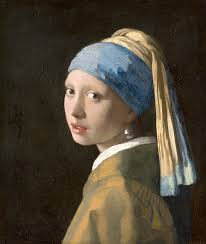Johannes Vermeer’s "Girl with a Pearl Earring," painted around 1665, is an iconic work of the Dutch Golden Age that captivates viewers with its exquisite simplicity and enigmatic charm. Often referred to as the "Mona Lisa of the North," this masterpiece showcases Vermeer’s extraordinary ability to convey emotion and depth through subtlety and meticulous detail.
The elements of art in "Girl with a Pearl Earring" inspire awe primarily through Vermeer’s use of light, color, and texture. The soft, diffused light that illuminates the girl's face creates a delicate and ethereal quality, evoking a sense of intimacy. The contrast between the dark background and her luminous skin highlights her features, drawing the viewer's attention to her expressive eyes and the iconic pearl earring.
The color palette is muted and rich, featuring deep blues and yellows that evoke warmth and serenity. This juxtaposition of light and shadow enhances the girl's three-dimensionality, making her appear almost lifelike. The subtle play of light on the earring adds an element of intrigue and allure, captivating viewers with its beauty.
The girl's expression, a blend of curiosity and mystery, elicits emotions from admiration to longing. Her gaze appears to follow the viewer, creating an engaging dialogue that invites personal reflection. This profound emotional connection encourages viewers to ponder her story and the world she inhabits.
"Girl with a Pearl Earring" is typically presented in an intimate setting, allowing viewers to appreciate its intricate details up close. The painting’s compact size (about 17.5 x 15 inches) enhances its personal nature, making it feel like a cherished glimpse into a private moment. If I had the opportunity, I would love to own a copy of this work, as its beauty and emotional depth resonate with me. It serves as a reminder of the power of art to convey complex human emotions and connections.
The backstory of "Girl with a Pearl Earring" is relatively shrouded in mystery, as little is known about the girl's identity or the circumstances of the painting’s creation. Some scholars speculate that she may have been a servant or perhaps even a model for Vermeer. The work is emblematic of the genre of tronie, a type of painting that features exaggerated facial expressions or costumes rather than depicting a specific individual.
The rise of the merchant classes is pivotal in understanding "Girl with a Pearl Earring." During this time, art became more accessible, and the subjects of paintings began to shift from religious figures and nobility to everyday people and scenes of domestic life. This change signifies a growing interest in individual identity and personal expression, aligning with the values of a burgeoning middle class that valued both beauty and the unique qualities of the human experience.
In contrast, Leonardo da Vinci’s "Lady with an Ermine," painted in the late 15th century, is a prime example of Renaissance portraiture emphasizing nobility and status. The subject, Cecilia Gallerani, is portrayed with a sense of grandeur, and the work underscores the influence of royalty and aristocracy. In comparison, Vermeer’s "Girl with a Pearl Earring" embodies a more intimate, personal connection, reflecting the democratization of art and the exploration of individual identity during the Dutch Golden Age.







I agree with your analysis and I think this painting is beautiful! I like the soft lighting and the way the shadows are a bit chunky. It created depth in the painting. I agree that the way she looks back at the viewer reminds me of longing and admiration. I also agree with your connection to the rise of the merchant class. Art grew and expanded throughout the classes. Instead of being mainly for the wealthy, others began to enjoy it as well. I personally feel like this ties into the mystery behind the painting. Not knowing this woman's background, it’s left up to the imagination. She could be anyone. This, along with the size of the painting shows that art doesn’t have to be incredibly grand or of someone well known to be considered beautiful. Art is for everyone's enjoyment.
ReplyDeleteThis is one of my favorite pieces of artwork, I did not know until reading your post that this piece was from this time period. I enjoyed reading your analysis of this painting, as well as I do agree with the soft lighting set at such an angle that creates chunky shadows. I also like how you added the mystery behind who this painting is depicting, I find this thought very interesting. In my opinion leaving the figure nameless leaves the viewer to use their imagination and asking a lot of what if questions.
ReplyDelete